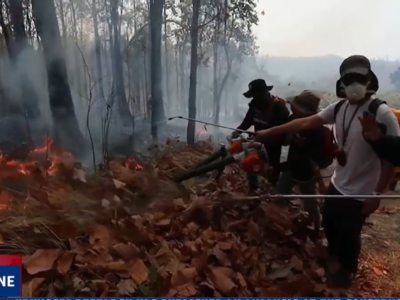
Hong Kong Wetland Park. Photo taken by Oiwan Lam
Despite its urban landscape, Hong Kong has been and remains an important stopping spot for migratory birds thanks to its small but well-preserved wetlands, in particular the Mai Po and Inner Deep Bay Ramsar Site.
However, the city's Northern Metropolis Plan which covers mass areas of wetlands, reed beds, paddy fields, and fish and shrimp ponds in northern New Territories, may transform the natural landscape and drive away migratory birds.
Every year, over 400 species of migratory birds, including endangered ones like black-faced spoonbills, stop over in the city’s wetlands during their summer and winter journeys along the East Asia-Australasian Flyway.
In addition to the 50,000 to 80,000 total migratory birds, the city’s wetlands are also home to local aquatic fauna, and marine and land wildlife.

A Black-Faced Spoonbill. Via Wikipedia license (CC BY-SA 4.0)

The black Tailed Godwit, a migratory bird species found in the Hong Kong Wetland park. Via Wikimedia license (CC BY-SA 4.0)
There are around 6,640 hectares of wetlands in Hong Kong, the majority of which are located near river mouths where freshwater meets the sea, where early settlers took advantage of the natural landscape for human-made fish and shrimp ponds as well as other aqua-agricultural activities. These fertile lands are homes to local aquatic fauna, marine, and land wildlife and serve as refueling stations for migratory birds, such as the Black-Tailed Godwit and rare Black Faced Spoonbill.
Currently, the city’s wetlands cover only 5 percent of its land area. Although the Hong Kong government has formulated strategies to preserve the city’s wetlands, environmental groups are worried that new developmental plans in northern New Territories, where major wetland conservation sites are located, may threaten the natural wonders.
Crowned as the world’s least affordable housing market for over a decade, developers have been battling for land to build homes and green buffers near wetlands are one of their major targets. Yet, thanks to pressure coming from green groups, the city’s Town Planning Board has been cautious in reviewing the related development plans.
Testing the government's commitment to wetland conservation
The three-decade-long battle between developers and green groups over developmental projects at the northern part of Nam Sang Wai, an ecological wetland site, serves as a barometer for measuring the city’s commitment to protecting its wetlands against development pressure.
The Nam Sang Wai Wetland is a conservation site with a natural river full of reedbeds that helps filter river water. Surrounding the wetland are fish ponds, wet agriculture lands and sparsely populated villages. The site, however, is very near the highly populated Yuen Long city and hence very accessible to the public.
Our reporter had a relaxing day off at the very conveniently located Nam Sang Wai, where she was able to immerse herself in nature and enjoy rustic and picturesque views. https://t.co/WHvoOHtoBr
— Coconuts Hong Kong (@CoconutsHK) October 15, 2022
Since the property market surged in the 1990s, lands surrounding Nam Sang Wai have faced huge development pressure. However, as green groups opposed large-scale and high-density development in the wetland buffer area, the government had been cautious in reviewing developmental projects. However, since 2014, it has approved a number of hotels, outlets, and low-density development projects to address the city's housing shortage problem.
Many are afraid that the wetlands will eventually vanish to serve the property market:
“In a few years, this will all be housing,” said one cyclist taking a break from riding around Nam Sang Wai, a 400-acre wedge of wetlands bounded by rivers and filled with fish ponds and reed beds. “People in Hong Kong only care about the economy.” https://t.co/o6nhUPQ4qQ
— The New York Times (@nytimes) November 18, 2018
Worse still, in recent years, residential buildings in newly proposed projects in Nam Sang Wai have become far higher in both height and density. A recent project, for example, involves 50 luxurious residential buildings, some as high as 34 stories. Conservation groups are worried that these tall buildings might obstruct the migratory birds’ flight paths.

An Impatiens chinensis plant, which is common in the Hong Kong wetland park. via Wikimedia license (CC BY-SA 4.0)

The Orange tip Butterfly, which can be found in the Hong Kong Wetland Park. Via Wikimedia license (CC BY-SA 4.0)
The project has been submitted for review to the city’s Town Planning Board last Friday, February 3 2023. A number of government departments, reportedly, have also spoken out against the project. The Agriculture, Fisheries and Conservation Department, for example, highlighted the fact that a luxurious housing project would destroy a semi-active fish pond, but developers had not conducted an environmental assessment or created a compensation plan. The Planning Department also pointed out that the piece of land could be appropriated for temporary public housing and that the current project would upset the general development blueprint of the Nam Sang Wai region.
Along with the Hong Kong government's HKD 100 billion (about USD 127,400,000) investment in the development of the Northern Metropolis, developers are more eager to encroach and capitalize on the natural wetland sceneries for their luxurious apartment buildings.
The Northern Metropolis development project is part of China’s Greater Bay Area strategic development plan. It covers about 30,000 hectares of land along the Shenzhen River and Deep Bay.
Although the government said it would embed a new proactive conservation policy in the grand Northern Metropolis development plan by turning 700 hectares of pre-existing private wetlands and fish ponds into conservation parks, the 20-year construction project is also set to turn the rural area into an IT hub and provide residential units for 2.5 million people, which is more than double its current population.
As the supply of housing units has been set as a top priority of the city’s administration headed by Chief Executive John Lee, green groups are uncertain if the government would maintain the balance between developmental and ecological needs, in particular when a concrete conservation plan is still absent.






